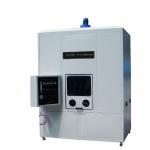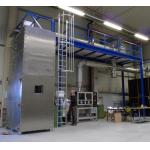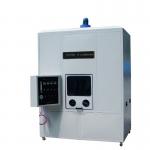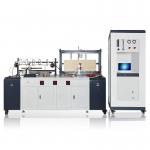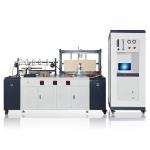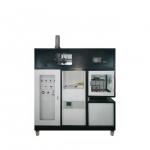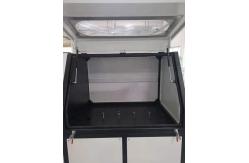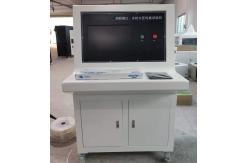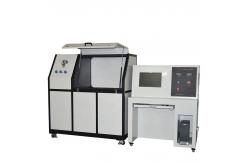In the domain of fire safety and materials research, customized
flammability test instruments have emerged as indispensable tools.
These instruments are meticulously designed to provide accurate and
detailed insights into the flammability characteristics of a wide
range of materials, thereby playing a pivotal role in various
industries. The Customized Flammability Test Instruments are a suite of
advanced testing devices that are dedicated to evaluating the
flammability of materials. They serve the needs of industries such
as manufacturing, construction, aerospace, and automotive, as well
as research institutions and regulatory bodies. The primary
objective is to determine parameters like ignition temperature,
flame spread rate, heat release rate, smoke production, and the
toxicity of combustion by-products. This information is crucial for
product design, quality control, and ensuring compliance with fire
safety regulations. - Robust and Heat-Resistant Build Quality
- These instruments are constructed with high-strength,
heat-resistant materials. The frames are typically made of alloy
steel or stainless steel, which can endure the extreme temperatures
and mechanical stresses associated with flammability testing. The
interior chambers are lined with refractory ceramics or
high-temperature insulation materials, capable of withstanding
temperatures up to 1800°C. The doors and access panels are
engineered with precision seals and locking mechanisms to ensure a
tight and secure enclosure during testing. A viewing window, made
of heat-strengthened glass or a specialized ceramic material,
allows for visual monitoring of the test without compromising the
integrity of the test environment.
- Precision Temperature and Flame Control Systems
- Temperature Control: The instruments can precisely regulate the
temperature within a wide range, from ambient to 1500°C, with an
accuracy of ±3°C. They utilize advanced heating elements, such as
silicon carbide or molybdenum disilicide heaters, combined with a
sophisticated PID (Proportional-Integral-Derivative) control
algorithm. Multiple thermocouples are strategically placed
throughout the chamber to ensure uniform temperature distribution
and rapid response to any temperature deviations. The control panel
allows for the programming of complex temperature profiles,
including ramping, holding, and cycling, to mimic various
real-world fire scenarios.
- Flame Control: To accurately simulate the heat transfer during a
fire, the instruments can adjust the flame characteristics. They
can generate flames with different intensities, from a gentle pilot
flame to a powerful, turbulent flame. The fuel supply and air
mixture can be precisely regulated, allowing for the customization
of flame temperature, shape, and color. This is essential for
testing the response of materials under different fire conditions,
such as the slow-burning flames of a smoldering fire or the intense
heat of a flashover.
- Advanced Instrumentation and Data Acquisition Capabilities
- The Customized Flammability Test Instruments are equipped with a
comprehensive array of sensors and measurement devices. In addition
to temperature and flame sensors, they include optical sensors for
monitoring flame height, luminosity, and color. Smoke density
sensors, based on light attenuation principles, accurately measure
the amount and density of smoke produced. Gas sensors, capable of
detecting a wide range of toxic and combustible gases, provide
valuable information about the chemical composition of the gases
emitted. These sensors are connected to a high-speed data
acquisition system that records and stores all relevant data. The
data acquisition system offers a sampling rate of up to 6000
samples per second, ensuring that even the most transient and
minute changes in parameters are captured. The collected data can
be analyzed in real-time or retrieved later for in-depth studies
using specialized software, which provides detailed reports and
graphical representations.
- Versatile Testing Modes and Configurations
- The instruments offer a variety of testing modes to accommodate
different sample types and testing requirements. They can perform
horizontal and vertical flame spread tests, cone calorimeter tests,
and fire resistance tests. In horizontal flame spread tests, the
behavior of a material's surface as the flame travels across it is
evaluated. Cone calorimeter tests measure the heat release rate and
other combustion parameters of a sample under a controlled radiant
heat flux. Fire resistance tests assess the ability of a structure
or component to withstand fire for a specific period without losing
its integrity. The instruments can also be configured to test the
effectiveness of fire suppression systems, such as sprinklers or
fire extinguishers, by simulating a fire and observing the system's
response.
- Compliance with Stringent Industry Standards
- The Customized Flammability Test Instruments are designed to comply
with a wide range of international and national fire safety
standards. They adhere to ASTM (American Society for Testing and
Materials) standards, such as ASTM E84 for surface burning
characteristics, ASTM E1354 for heat and visible smoke release
rates, and ASTM E662 for smoke density. They also meet ISO
(International Organization for Standardization) standards,
including ISO 5660 for reaction-to-fire tests and ISO 1716 for
calorific value determination. This compliance ensures that the
test results are recognized and accepted by regulatory bodies and
industry peers, facilitating product certification and market
access.
- Chamber Size and Capacity
- The instruments are available in different chamber sizes to suit
various sample sizes and testing volumes. Smaller chambers may have
interior dimensions of 0.4 meters x 0.4 meters x 0.4 meters,
suitable for testing small specimens or individual components.
Medium-sized chambers can measure 0.8 meters x 0.8 meters x 0.8
meters, providing sufficient space for testing larger samples or a
batch of products. Larger chambers, with dimensions exceeding 1.5
meters x 1.5 meters x 1.5 meters, are ideal for full-scale testing
of building structures or large industrial equipment. The interior
volume and shape are carefully designed to ensure proper air
circulation and uniform exposure of the sample to the fire and
environmental conditions.
- Temperature Range and Accuracy
- As mentioned earlier, the temperature can be controlled from
ambient to 1500°C, with an accuracy of ±3°C. The temperature ramp
rate can be adjusted from 1°C per minute to 80°C per minute,
allowing for the simulation of different fire growth rates. For
example, a slow ramp rate can be used to study the thermal
degradation of a material over time, while a rapid ramp rate can
mimic the sudden increase in temperature during a flashover event.
- Flame Intensity and Control Parameters
- The flame intensity can be adjusted over a wide range, with a
maximum heat output equivalent to several megawatts per square
meter. The fuel flow rate can be varied from a few milliliters per
minute to several liters per minute, and the air-fuel ratio can be
precisely controlled within a range of 1:1 to 18:1. These
parameters enable the creation of flames with different
characteristics, from a small, stable flame for precision testing
to a large, turbulent flame for more severe fire simulations.
- Data Acquisition Rate and Resolution
- The data acquisition system samples sensor data at a rate of 6000
samples per second. The temperature sensor has a resolution of
0.1°C, the smoke density sensor can detect changes as small as
0.01% opacity, and the gas sensors have a sensitivity in the parts
per million (ppm) range for most common gases. This high-resolution
data capture provides detailed insights into the fire behavior of
the tested samples.
- Compliance with Key Fire Testing Standards
- The instruments comply with ASTM E84, ASTM E1354, ASTM E662, ISO
5660, and ISO 1716, among other relevant standards. They can also
be customized to meet specific requirements of other industry
standards or regulatory codes, ensuring their adaptability to
different applications.
- Accurate Simulation of Fire Scenarios
- The primary function of the instruments is to provide a highly
accurate and realistic simulation of fire conditions. By precisely
controlling temperature, flame characteristics, and other factors,
it allows for the comprehensive evaluation of how materials and
products will perform in an actual fire. For example, it can
determine if a building material will contribute to the spread of
fire, if a product will release toxic gases that could endanger
occupants, or if a component will maintain its structural integrity
under fire exposure. This information is invaluable for architects,
engineers, and manufacturers to make informed decisions about fire
safety in their designs and products.
- Enhanced Product Development and Quality Assurance
- Through detailed flammability evaluation, manufacturers can
identify and address potential fire safety issues in their
products. If a material shows a high flame spread rate or excessive
smoke production, they can modify the formulation or design to
improve its fire resistance. This leads to the development of safer
and more reliable products, reducing the risk of fire-related
accidents and ensuring customer satisfaction. The instruments also
serve as a crucial tool for quality control, ensuring that each
batch of products meets the required fire safety standards.
- Support for Regulatory Compliance and Certification
- Regulatory bodies rely on accurate fire test results to enforce
fire safety regulations. The Customized Flammability Test
Instruments enable manufacturers to conduct tests in accordance
with recognized standards, providing the necessary data for
regulatory compliance and product certification. This helps in
building a safer built environment and promoting public safety.
- Stringent Manufacturing Process
- The flammability test instruments are manufactured under strict
quality control procedures. Each component, from the heating
elements to the sensors and control panel, is carefully sourced and
inspected for quality and performance. The assembly process is
carried out by trained technicians in a clean and controlled
environment. The instruments undergo a series of calibration and
validation tests during the manufacturing process to ensure that
they meet the required accuracy and performance standards.
- The calibration of the temperature, flame, and other sensors is a
critical part of the manufacturing process. It is performed using
traceable reference standards that are calibrated to the highest
levels of accuracy, guaranteeing the reproducibility of the test
results. Rigorous quality audits and inspections are conducted at
various stages of production to maintain the highest level of
product quality and compliance with fire safety standards.
- Quality Certification and Validation
Our instruments have obtained relevant quality certifications and
has been validated by independent fire testing laboratories. It has
been proven to provide accurate and reliable test results,
conforming to the relevant industry standards. We also continuously
update and improve our product based on the latest technological
advancements and customer feedback from the fire safety industry to
ensure its long-term performance and compliance.
- Building Materials Testing
- A leading building materials manufacturer used the Customized
Flammability Test Instruments to test a new type of wall insulation
material. The tests revealed that the material had a low heat
release rate and minimal smoke production, making it a highly
fire-safe option. This led to the successful marketing of the
product as a superior alternative to traditional insulation
materials, meeting the growing demand for energy-efficient and
fire-resistant building products.
- A construction company tested different types of roofing materials
in the instruments. The testing identified that one particular
roofing material had a high flame spread rate. By using a
fire-retardant coating and retesting, they were able to improve the
fire performance of the roofing material and ensure compliance with
building codes.
- Manufacturing and Product Design
- An electronics manufacturer tested the fire resistance of their new
smartphone casing. The instruments helped them identify potential
weak points in the casing's design, such as areas where the plastic
could melt and release toxic gases. By redesigning the casing and
using fire-resistant materials, they were able to enhance the fire
safety of their product and protect consumers.
- A furniture manufacturer evaluated the flammability of their
upholstery fabrics. The tests showed that some fabrics had a poor
fire resistance rating. By switching to fabrics with better
fire-retardant properties and testing them again, they were able to
improve the fire safety of their furniture and gain a competitive
edge in the market.
- Research and Development
- A research institution used the Customized Flammability Test
Instruments to study the behavior of new composite materials under
fire conditions. The detailed data obtained from the tests enabled
them to develop a new generation of composite materials with
improved fire resistance, which could be used in various
industries, including aerospace and automotive.
- Another research team investigated the effectiveness of different
fire suppression agents. The instruments allowed them to simulate
real-fire scenarios and evaluate the performance of the agents,
leading to the development of more efficient fire suppression
strategies.
- Pre-Sales Technical Consultation
Our team of fire safety experts provides in-depth technical
consultations to help customers understand the capabilities and
suitability of the Customized Flammability Test Instruments for
their specific testing needs. We offer demonstrations and training,
tailored to the fire safety industry, to familiarize customers with
the operation and functionality of the instruments before purchase.
We also assist in selecting the appropriate test methods and
accessories based on the materials or products to be tested. - After-Sales Service and Maintenance
We offer comprehensive after-sales service, including on-site
installation and commissioning. Our technicians are available for
regular maintenance, calibration, and emergency repairs. We provide
spare parts and upgrades to keep the test instruments operating at
peak performance. We also offer service contracts that include
preventive maintenance and priority technical support, ensuring the
long-term reliability and availability of the instruments for
flammability testing. - Training and Technical Support
We conduct training programs for new users to ensure they can
effectively operate the Customized Flammability Test Instruments
and interpret the test results. Our technical support team is
available 24/7 to answer questions, provide troubleshooting
assistance, and offer guidance on test method optimization and
compliance with fire safety standards. We also provide software
updates and support for the data acquisition and analysis systems,
enabling customers to take full advantage of the latest features
and technologies in flammability testing.
The Customized Flammability Test Instruments are an essential asset
for any organization involved in fire safety testing and product
development. If you are looking to enhance your flammability
testing capabilities, ensure compliance with industry standards, or
drive innovation in fire safety, this is the ideal solution.
Contact us today to learn more and get a customized quotation. Let
us help you unlock the full potential of your flammability testing
and product quality assurance. |
